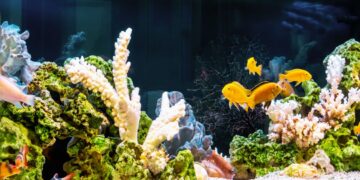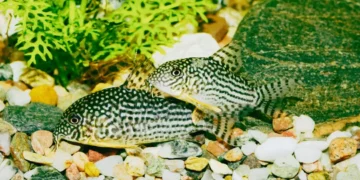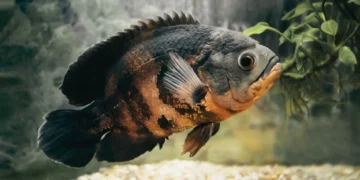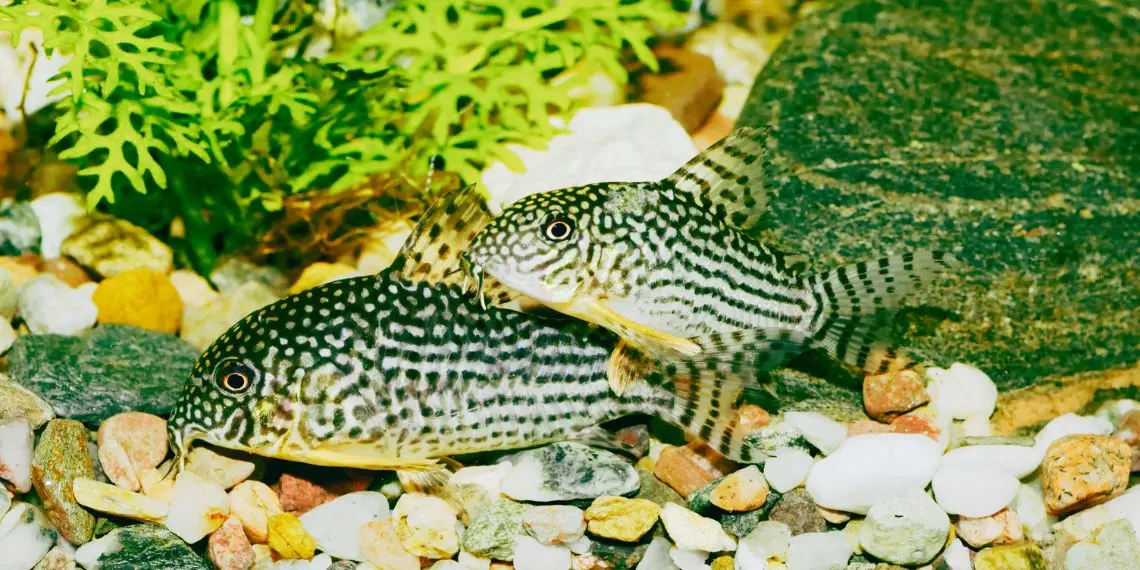Are you considering adding some bottom feeder fish to your small tank?
In this guide, we’ll explore the Best Bottom Feeder Fish for Small Tank.
These fish not only add to the beauty of your aquarium but also help keep it clean and balanced.
Let’s dive in and discover the top picks for your small tank!
1. Corydoras Catfish:
These small, peaceful catfish are popular bottom dwellers known for their social behavior and scavenging habits. They come in various species, such as Bronze Corydoras (Corydoras aeneus) and Panda Corydoras (Corydoras panda).

Why Corydoras Catfish are Ideal for Small Tanks
Small Size, Big Personality
- Perfect Fit: Corydoras catfish are small in size, making them suitable for small tanks without overcrowding.
- Friendly Dwellers: They’re known for their peaceful nature, getting along well with other tank mates.
Excellent Cleaners
- Scavenger Habits: Corydoras are natural scavengers, constantly foraging for food scraps and debris at the bottom of the tank.
- Algae Control: They also help in keeping algae growth in check, ensuring a clean and healthy environment.
Active and Entertaining
- Active Behavior: Corydoras are active bottom dwellers, constantly moving around the tank, adding life and vibrancy to the setup.
- Interesting to Watch: Their playful antics and social behavior make them a joy to watch for aquarium enthusiasts of all ages.
Wide Variety Available
- Diverse Species: There are many species of Corydoras catfish available, offering a range of colors, patterns, and sizes to choose from.
- Options for Everyone: Whether you prefer the classic Bronze Corydoras or the striking Panda Corydoras, there’s a variety to suit every taste.
Hardy and Easy to Care For
- Robust Fish: Corydoras are hardy fish, capable of tolerating a range of water conditions, making them ideal for beginner aquarists.
- Low Maintenance: With simple care requirements, they’re easy to care for, requiring minimal effort to keep healthy and happy.
Community Tank Compatibility
- Peaceful Coexistence: Corydoras are peaceful fish, making them compatible with a wide range of tank mates, including small community fish and non-aggressive species.
- Balanced Ecosystem: They contribute to a balanced ecosystem by helping with tank cleanup while cohabiting peacefully with other fish.
Educational Value
- Learning Opportunity: Keeping Corydoras catfish can provide valuable educational experiences, especially for children, teaching them about aquatic life and responsible pet ownership.
- Hands-On Experience: Observing their behaviors and interactions in the tank offers insights into the natural world and ecosystem dynamics.
2. Otocinclus Catfish:
Otocinclus catfish, often referred to as “otos,” are tiny algae eaters that are ideal for small tanks. They help keep the tank clean by consuming algae from surfaces.

Why Otocinclus Catfish are Ideal for Small Tanks
Tiny Yet Mighty
- Perfect Size: Otocinclus catfish are small, making them an excellent choice for small tanks without taking up too much space.
- Not Overbearing: Their small size ensures they won’t overpower the tank or intimidate other fish.
Algae Eating Experts
- Algae Control: Otocinclus catfish are voracious algae eaters, helping to keep the tank clean and free from unsightly algae growth.
- Efficient Cleaners: They tirelessly scour surfaces for algae, ensuring a pristine and healthy environment for other tank inhabitants.
Peaceful and Placid
- Gentle Dwellers: Otocinclus catfish are peaceful by nature, making them compatible with a wide variety of tank mates.
- No Trouble: They won’t cause any disturbances or conflicts in the tank, contributing to a harmonious aquatic community.
Graceful Swimmers
- Elegant Movement: Otocinclus catfish exhibit graceful swimming behavior, adding elegance and beauty to the tank.
- Mesmerizing to Watch: Their fluid movements and delicate fins make them a captivating sight for aquarium enthusiasts.
Low Maintenance
- Easy Care: Otocinclus catfish have simple care requirements, making them suitable for beginner aquarists and busy individuals.
- Minimal Effort: With their efficient algae-eating habits, they require little maintenance beyond regular tank upkeep.
Small Group Friendly
- Schooling Behavior: Otocinclus catfish are social creatures that thrive in groups, so keeping them in small groups enhances their well-being.
- Enhanced Comfort: Being in a group provides them with security and companionship, promoting their natural behaviors.
Educational Value
- Learning Opportunity: Keeping Otocinclus catfish can be educational, especially for children, teaching them about the importance of algae control and ecosystem balance.
- Hands-On Experience: Observing their behaviors and interactions in the tank offers insights into the natural world and the interconnectedness of aquatic life.
3. Bristlenose Pleco (Ancistrus sp.):
Bristlenose plecos are small, hardy plecos that are suitable for small tanks. They are efficient algae eaters and can also feed on leftover food.

Why Bristlenose Pleco (Ancistrus sp.) is Perfect for Small Tanks
Efficient Algae Control
- Algae Eating Expert: Bristlenose plecos are renowned for their voracious appetite for algae, helping to keep the tank clean and free from unsightly algae growth.
- Continuous Grazing: They constantly graze on algae-covered surfaces, ensuring a tidy and well-maintained aquarium environment.
Small Size, Big Impact
- Compact Build: Bristlenose plecos have a small size, making them suitable for smaller tank setups without overcrowding.
- Space Savers: Their compact size allows them to navigate tight spaces and explore every nook and cranny of the tank.
Peaceful and Non-Disruptive
- Easygoing Nature: Bristlenose plecos are peaceful and non-aggressive, making them excellent tank mates for a variety of fish species.
- Low Profile: They prefer to stick to the bottom of the tank, minimizing conflicts with other fish and ensuring a harmonious community.
Unique Aesthetic Appeal
- Distinctive Appearance: Bristlenose plecos have a unique appearance with their characteristic bristle-like growths on their snouts, adding visual interest to the tank.
- Variety of Colors: They come in various color morphs, including common brown, albino, and calico, allowing aquarists to choose based on personal preference.
Hardy and Low Maintenance
- Hardiness: Bristlenose plecos are hardy fish, capable of tolerating fluctuations in water parameters, making them suitable for beginner aquarists.
- Minimal Care Requirements: They require minimal maintenance, thriving in well-maintained tanks with adequate hiding places and vegetation.
Compatibility with Small Tanks
- Space Efficient: Bristlenose plecos don’t require a large territory, making them well-suited for small tanks where space is limited.
- Community Friendly: They coexist peacefully with a variety of fish species, contributing to a balanced and harmonious community tank.
Longevity and Durability
- Long Lifespan: With proper care, Bristlenose plecos can live for several years, providing long-term benefits to the tank ecosystem.
- Resilience: They are resilient to common aquarium ailments, making them a reliable addition to any small tank setup.
4. Kuhli Loach (Pangio kuhlii):
Kuhli loaches are slender, eel-like fish that are active bottom dwellers. They are peaceful and can help clean up food debris and small invertebrates.

Why Kuhli Loach (Pangio kuhlii) is Ideal for Small Tanks
Active Bottom Dwellers
- Always on the Move: Kuhli loaches are lively fish that constantly explore the bottom of the tank, adding movement and activity to your aquarium.
- Fascinating to Watch: Their curious behavior and slithery movements make them entertaining to observe, especially in smaller tanks where their actions are more visible.
Sleek and Slim Design
- Space Savers: With their slender bodies, Kuhli loaches take up minimal space in the tank, allowing for more room for other fish and decorations.
- Fit Anywhere: They can squeeze into tight spaces and hide among plants and decorations, making the most of the available tank space.
Peaceful Community Members
- Non-Aggressive: Kuhli loaches are peaceful by nature, rarely showing aggression towards other tank inhabitants.
- Friendly Coexistence: They get along well with a variety of fish species, making them suitable for community tanks with small or peaceful fish.
Effective Cleaners
- Diligent Scavengers: Kuhli loaches are proficient scavengers, constantly searching for food scraps and small invertebrates on the tank bottom.
- Help with Cleanup: They contribute to maintaining a clean environment by consuming leftover food and debris, reducing the need for manual tank maintenance.
Small Tank Compatibility
- Perfect for Limited Spaces: Kuhli loaches thrive in small tanks, making them an excellent choice for aquarists with limited space.
- Adaptable: They adapt well to smaller environments, provided there are adequate hiding spots and vegetation to make them feel secure.
Unique Appearance
- Distinctive Look: With their eel-like bodies and alternating bands of color, Kuhli loaches have a unique and eye-catching appearance.
- Variety of Patterns: They come in various color patterns, ranging from dark brown to light yellow, adding visual interest to the tank.
Low Maintenance Requirements
- Easy to Care For: Kuhli loaches have straightforward care requirements, thriving in well-maintained tanks with suitable water parameters.
- Minimal Effort: They don’t demand specialized care, making them suitable for beginner aquarists and enthusiasts looking for low-maintenance fish.
5. Pygmy Corydoras (Corydoras pygmaeus):
Pygmy corydoras are even smaller than other Corydoras species, making them perfect for nano and small aquariums. They have similar behavior to other Corydoras and are excellent scavengers.

Why Pygmy Corydoras (Corydoras pygmaeus) are Perfect for Small Tanks
Tiny Yet Active
- Compact Size: Pygmy corydoras are small in size, making them ideal for small tanks with limited space.
- Energetic Swimmers: Despite their small stature, they are active fish, constantly exploring the tank bottom and adding movement to the aquarium.
Peaceful Community Members
- Gentle Nature: Pygmy corydoras are peaceful and non-aggressive, making them suitable tank mates for a variety of small fish species.
- Harmonious Coexistence: They get along well with other peaceful fish, contributing to a calm and balanced community tank.
Excellent Cleaners
- Efficient Scavengers: Pygmy corydoras have a natural inclination for scavenging, eagerly searching for food scraps and debris on the tank bottom.
- Aid in Tank Maintenance: By consuming leftover food and organic matter, they help keep the tank clean and reduce the need for manual cleaning.
Schooling Behavior
- Social Creatures: Pygmy corydoras are schooling fish, thriving in groups of their own kind.
- Schooling Benefits: Keeping them in a group not only satisfies their social needs but also enhances their activity levels and overall well-being.
Adaptable to Small Tanks
- Space-Saving: Their small size allows them to thrive in compact tank setups without overcrowding.
- Suitable for Nano Tanks: Pygmy corydoras are particularly well-suited for nano tanks and small aquariums, providing a lively presence in limited spaces.
Low Maintenance Requirements
- Easy to Care For: Pygmy corydoras have simple care requirements, making them suitable for beginner aquarists and experienced hobbyists alike.
- Minimal Effort: With proper tank maintenance and suitable water conditions, they thrive with minimal effort on the part of the aquarist.
Educational Value
- Learning Opportunity: Keeping Pygmy corydoras can provide valuable educational experiences, especially for children, teaching them about aquatic life and responsible pet ownership.
- Observational Learning: Observing their behaviors and interactions in the tank offers insights into natural behaviors and ecosystem dynamics.
6. Chinese Algae Eater (Gyrinocheilus aymonieri):
While they can outgrow very small tanks, Chinese algae eaters can be suitable for slightly larger setups. They are efficient algae eaters but can become territorial as they mature.
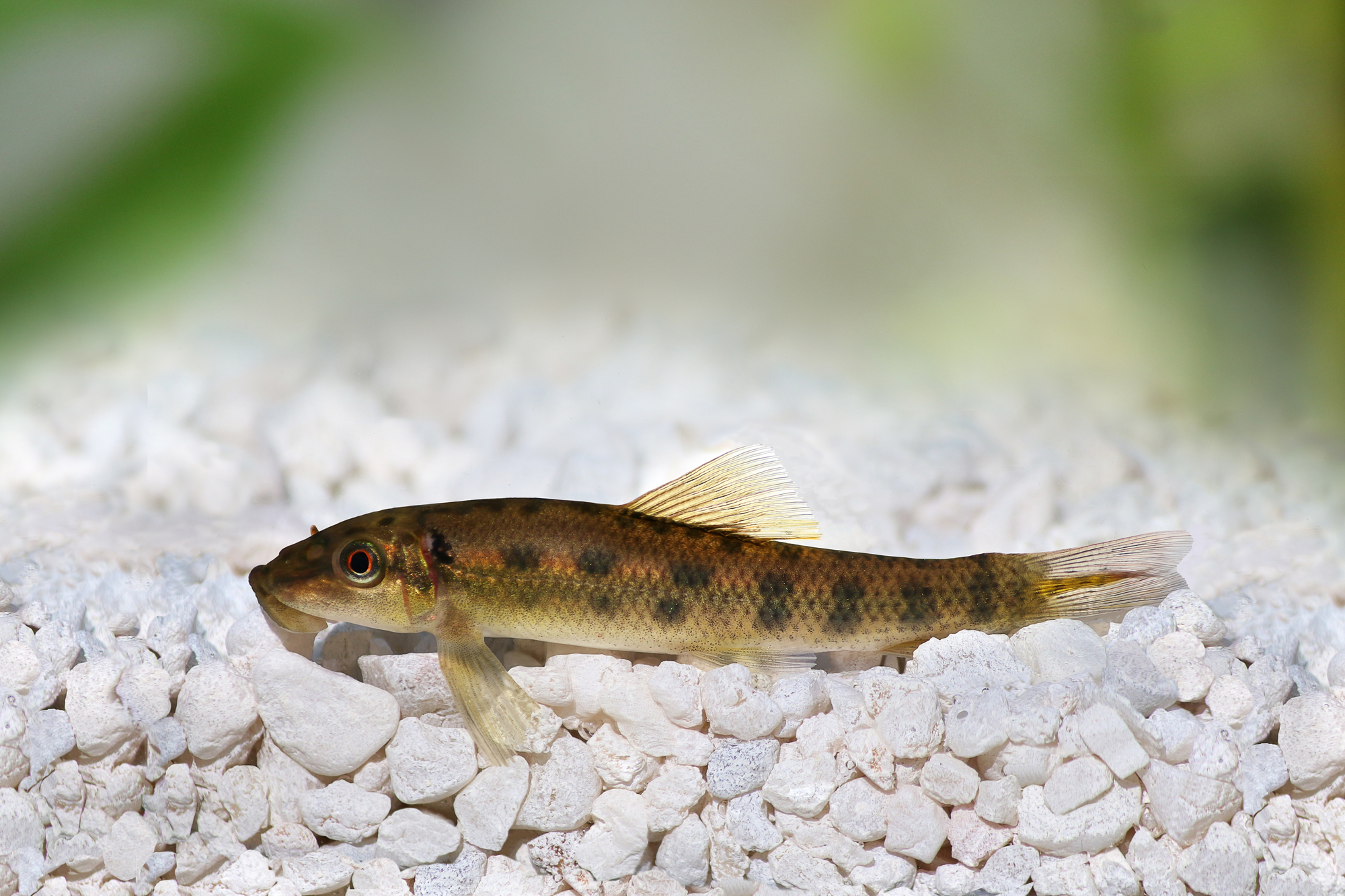
Why Chinese Algae Eater (Gyrinocheilus aymonieri) Might Not Be Ideal for Small Tanks
Aggressive Behavior
- Territorial Nature: Chinese algae eaters can become territorial as they mature, leading to aggression towards other tank mates.
- Not Suitable for Small Tanks: In confined spaces, their aggressive behavior can cause stress and harm to other fish, disrupting the harmony of the tank.
Large Size Potential
- Growing Giants: Chinese algae eaters can grow quite large, reaching up to 6 inches or more in length.
- Space Requirements: Their substantial size makes them unsuitable for small tanks, as they need ample swimming space to thrive.
Limited Algae Control
- Selective Diet: While they are marketed as algae eaters, Chinese algae eaters have a tendency to become less interested in algae as they grow older.
- Alternative Diets: They may switch to consuming fish food instead of algae, leading to inadequate algae control in the tank.
Maintenance Challenges
- High Maintenance: Chinese algae eaters require diligent care and maintenance to ensure their well-being.
- Water Quality: They are sensitive to poor water conditions, requiring pristine water parameters to prevent stress and disease.
Compatibility Concerns
- Aggression Towards Tank Mates: Chinese algae eaters may exhibit aggressive behavior towards other bottom-dwelling fish and territorial disputes with similarly sized or smaller tank mates.
- Limited Tank Mate Options: Their aggressive tendencies restrict the choice of compatible tank mates, making it challenging to maintain a peaceful community tank.
Longevity and Commitment
- Long Lifespan: Chinese algae eaters have a relatively long lifespan, living up to 10 years or more with proper care.
- Long-Term Commitment: Acquiring a Chinese algae eater requires a commitment to providing suitable housing and care for the duration of their lifespan.
Alternative Options
- More Suitable Alternatives: There are other bottom feeder fish species that are better suited for small tanks, such as Corydoras catfish, Otocinclus catfish, and Bristlenose plecos.
- Safer Choices: Choosing fish species with peaceful temperaments and suitable sizes ensures a harmonious and balanced aquarium environment.
7. Bamboo Shrimp (Atyopsis moluccensis):
Bamboo shrimp are filter feeders that sift through the substrate and tank surfaces for food particles. They are peaceful and add an interesting aesthetic to the tank with their unique appearance.

Why Bamboo Shrimp (Atyopsis moluccensis) Can Be a Great Addition to Small Tanks
Efficient Filter Feeders
- Natural Filter Feeders: Bamboo shrimp are adept at filtering water for tiny food particles, including algae, plankton, and detritus.
- Improves Water Quality: Their feeding habits help to maintain clean water conditions by reducing organic waste and algae buildup.
Peaceful Nature
- Gentle Disposition: Bamboo shrimp are peaceful creatures, making them suitable tank mates for a variety of fish species.
- Harmonious Community: They coexist well with other non-aggressive fish, contributing to a calm and balanced aquarium environment.
Unique Aesthetic Appeal
- Distinctive Appearance: Bamboo shrimp have a striking appearance with their long, feathery appendages and transparent bodies.
- Visual Interest: Their unique appearance adds visual interest to the tank and serves as a conversation starter for aquarium enthusiasts.
Safe for Small Tanks
- Space-Saving: Bamboo shrimp do not require a large territory, making them suitable for small tanks with limited space.
- Compact Size: Their small size allows them to comfortably fit into nano and small aquarium setups without overcrowding.
Easy to Care For
- Low Maintenance: Bamboo shrimp have simple care requirements, making them suitable for beginner aquarists.
- Feeding Needs: They can be fed with commercially available shrimp or fish food, algae wafers, and occasional supplemental feedings with liquid food for filter feeders.
Educational Value
- Learning Opportunity: Keeping Bamboo shrimp provides an educational experience for both children and adults, teaching them about aquatic ecosystems and the importance of invertebrates.
- Observational Learning: Observing their feeding behavior and interactions with other tank inhabitants offers insights into their natural behaviors and ecological role.
Fascinating Behavior
- Active Filter Feeding: Watching Bamboo shrimp filter feed can be fascinating and mesmerizing, providing hours of entertainment for aquarium enthusiasts.
- Interaction with Environment: They use their delicate appendages to sift through substrate and tank surfaces, showcasing their natural behaviors in the aquarium.
8. Nerite Snails (Neritina spp.):
Nerite snails are popular algae-eating snails that are suitable for small tanks. They come in various patterns and colors and are effective at cleaning algae from surfaces.

Why Nerite Snails (Neritina spp.) are Popular for Small Tanks
Superior Algae Control
- Efficient Algae Eaters: Nerite snails are excellent at consuming various types of algae, including green algae, diatoms, and even tough to remove algae like brown algae.
- Cleaner Tanks: Their constant grazing helps keep the tank glass, decorations, and substrate free from unsightly algae growth.
Peaceful Coexistence
- Non-Invasive: Nerite snails are peaceful creatures that won’t bother other tank inhabitants.
- Compatible with Small Tanks: Their small size and gentle nature make them perfect for small aquariums with limited space.
Varied Patterns and Colors
- Attractive Appearance: Nerite snails come in a variety of striking patterns and colors, such as zebra, tiger, and horned nerites.
- Visual Appeal: Their vibrant shells add visual interest to the tank, enhancing its overall aesthetic appeal.
Low Maintenance
- Easy to Care For: Nerite snails have simple care requirements, making them suitable for beginner aquarists.
- No Special Feeding: They mainly feed on algae and biofilm in the tank, requiring minimal supplemental feeding.
Natural Tank Cleaners
- Efficient Detritus Eaters: In addition to algae, Nerite snails consume decaying plant matter, uneaten food, and other organic debris.
- Promote Water Quality: Their scavenging behavior helps maintain clean water conditions, reducing the need for frequent tank cleanings.
No Breeding in Freshwater Tanks
- No Overpopulation Concerns: Nerite snails won’t reproduce in freshwater tanks, eliminating the risk of population explosions.
- Stable Population: You won’t have to worry about controlling snail populations, as they won’t multiply and overrun the tank.
Educational Value
- Learning Opportunity: Keeping Nerite snails can be educational for both children and adults, teaching them about the role of invertebrates in the aquarium ecosystem.
- Observational Learning: Observing their feeding habits and movements offers insights into their behavior and natural instincts.








